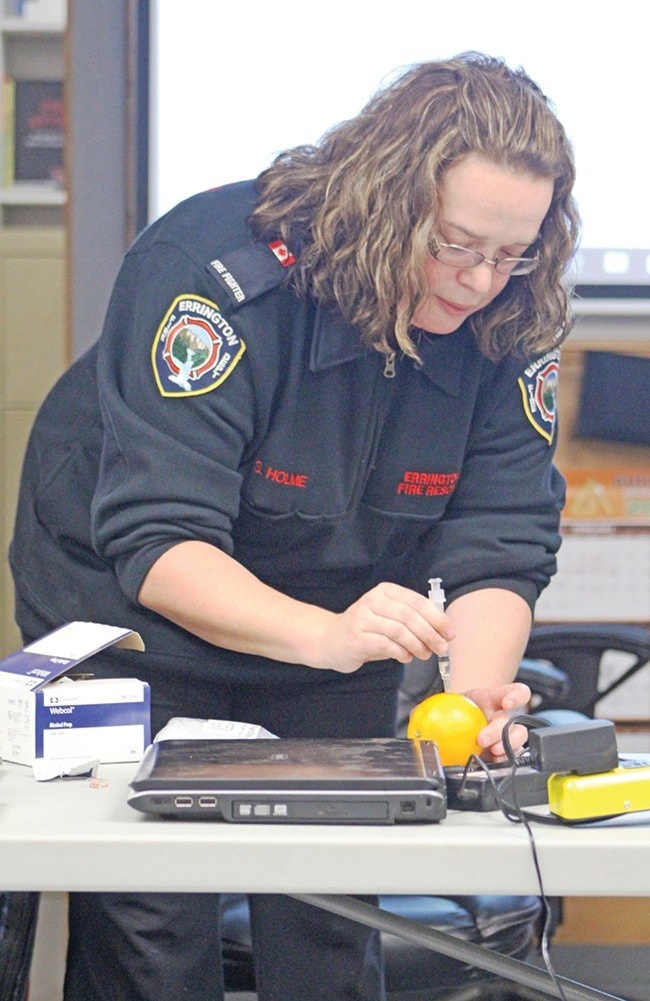While reports of overdoses in the Parksville Qualicum Beach area are not nearly as high as other regions of the province, some local volunteer fire departments are taking preventative measures against overdose calls.
In rural areas such as Errington and Dashwood, where ambulance wait times are higher than Parksville, the two volunteer fire departments have had training on how to administer the overdose-reversing drug naloxone.
The Errington Volunteer Fire Department did their training on Nov. 8.
Shawn Holme, a firefighter, instructor for the first responders program and a registered nurse, taught the volunteer firefighters in Errington how to give naloxone to a person suffering from an overdose. Holme showed the firefighters how to prepare the shot, clean the area for the shot and where they can administer the shot, which is either on the arm or mid-thigh.
EVFD fire Chief Troy Bater said one of the reasons why the department chose to get the naloxone kits was because of the rural nature of their coverage area.
"We have had a few overdoses this year," Bater said. "We decided — especially with our far-out area and the (fact that the) ambulance can't be there as quick — to try it for the year and see if it was cost-effective and worked."
According to HealthLinkBC, opioids are a class of drug or medication which includes morphine, heroin, methadone, fentanyl and oxycodone, which are most often prescribed for pain relief.
Bater said that since January, there have been four overdose calls in the Errington area, some of which have ended in deaths.
According to the B.C. Coroners Service, from January to September, there were 332 illicit drug overdoses with fentanyl-detected in B.C. Of those fentanyl-detected deaths, 31 were in the mid-Island region.
A report — Fentanyl-Detected Illicit Drug Overdose Deaths (2012-2016) — stated that preliminary data for January to September 2016 showed that Vancouver Island Health Authority (VIHA) was the second-highest region in B.C. with 75 fentanyl-detected overdoses, following Fraser Health Authority (110).
On Friday (Nov. 25), VIHA put out an urgent message to drug consumers to avoid using alone. Some of the strategies from VIHA to reduce the risk include: fix with a friend, trying a smaller amount of a new drug first, avoid using more than one drug at a time, carry naloxone and have an overdose plan.
Holme also said naloxone works for fentanyl, but not all opioids.
"It won't reverse the effects on certain medications," she said. "I mean it's a Catch-22 if you go on a call. Are people going to be honest with you with what they're using? They might not for fear of retribution from the RCMP."
The naloxone training, Bater said, is also for his members.
"It helps for my guys too, just for safety in case something happens, because we do go into places that we don't know what's in there," said Bater, adding that even the slightest exposure to fentanyl, or other opioids, can be dangerous.
Bater said the reaction to first responders receiving training for naloxone isn't always positive.
"Some members of the public don't like us doing it because why are we wasting our tax dollars on a junkie, but in my mind, everybody is equal," Bater said.
Dashwood Volunteer Fire Department Chief Nick Acciavatti said there hasn't been a push back against the training.
"(We) recognize and see the changing times and the need for it," Acciavatti said. "If we recognize it's a fentanyl overdose, we have the tools and the training to save somebody."
Acciavatti said some Dashwood members got the initial training a couple of weeks ago, and the rest of their department will be learning how to administer the drug in the new year.
In the past year, Acciavatti said the department hasn't had to deal with opioid overdoses, but he said they have done other overdose calls for medication.
"We're a rural area and we may or may not be there before the ambulance," Acciavatti said. "It's just another tool in the toolbox to help save lives."
In other areas, such as Qualicum Beach, fire Chief Darryl Kohse said while they haven't been called to any overdoses this year, they are looking into training.
"We have had issues in the past with people visiting the community," Kohse said, adding that having naloxone could have had some benefit.
Parksville Volunteer Fire Department Chief Marc Norris said they're currently looking at balancing the need for the training, since there is B.C. ambulance service in the city.
"There's a big difference in Parksville because the vast majority of the time B.C. ambulance responds in a timely manner," Norris said, adding that the ambulance paramedics occasionally need the fire department's support.
Norris said it's something his department looking at to see if there's more of a need.
"We know that there are certain issues around opioids and fentanyl in the forefront, and we're certainly keeping our eye on it," Norris said.
